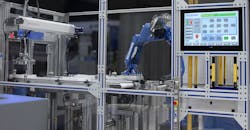The OEE Challenge: How Advanced Motion Controllers Minimize Downtime
Plants are operating in overdrive. Whether it's global competition, the rise of e-commerce or the use of 3-D printing, manufacturers are feeling the pressure to increase throughput and productivity. This fast-paced, on-demand environment is putting a strain on packaging lines as manufacturers are handling more customized products with shorter lead times.
To address some of these productivity issues, plants are placing an increasing emphasis on overall equipment effectiveness (OEE). OEE is one of the key metrics manufacturers use to measure productivity and machine performance. "OEE exposes yield issues on raw materials, quality cost issues and labor cost issues," writes Larry Fast, founder and president of Pathways to Manufacturing Excellence and IndustryWeek contributor.
OEE takes into account:
- Performance – the ratio of actual run rate/ideal run rate
- Quality – the ratio of good units/total units
- Machine availability – the ratio of operating time/planned production time
Many manufacturers, though, struggle to boost OEE on packaging lines because their automation solutions are underperforming, says Jacky Wong, product engineering and marketing manager for the Drives & Motion division at Yaskawa America Inc. Manufacturers may opt for a single vendor to provide all of their automation solutions because they're comfortable with a particular supplier, Wong says. But an automation supplier known for programmable logic controllers (PLCs) may not excel at motion controllers.
"One vendor may be known in the market for great PLCs, but their motion-control applications may not be the best," Wong says.
In a traditional PLC-centric approach, OEE may suffer because manufacturers must maintain the motion controllers more frequently to reduce downtime.
"Some vendors are not known for long-lasting products," Wong says. "They have a main core product, such as PLCs, and then they offer amps and motors that could be a resell product."
How High-Performing Motion Controllers Boost OEE
Performance of a packaging line is often tied to the motion control solution. Motion controllers ensure distinct automated processes work in harmony. For example, a stamping press or cutting tool may need to know when to stamp or cut a part as it moves down a conveyor. Some PLCs may not be able to handle that level of precision because they lack the necessary software or network speed, Wong says.
Also, some motion control solutions may have more advanced capabilities that can increase throughput. Some of the more sophisticated motion control electronics employ advanced servo algorithms that help decrease settling time of discrete machine movements. Even a small decrease in the settling time of each discrete machine movement in a production cycle can result in a significant reduction in overall production cycle time. This leads to more units being shipped per hour and a lower overall cost per unit, Wong says.
High-performing motion controllers can help manufacturers improve each of the three critical OEE inputs. For instance, Yaskawa conducted an internal study to determine the out-of-box failure rate of 100,000 motors the company shipped to customers. Some motor manufacturers set failure rate goals around 0.5%, which in this case would be 500 motors. Of the 100,000 motors that Yaskawa shipped, customers returned only seven for warranty repairs, Wong says.
In addition, Yaskawa's variable frequency drives (VFDs) include "life monitors" that help manufacturers perform preventive maintenance. VFDs with life monitors send notifications and warnings when consumable components, such as cooling fans, DC bus capacitors and inrush relays, are nearing the end of their predicted lifespan so they can be replaced prior to failure during operation.
"One of the worst things that can happen to a manufacturer is unplanned downtime," Wong says. "Ideally, machine builders will incorporate some type of preventive maintenance technologies into their machines to reduce potential downtime."
Yaskawa's MPiec Series controllers include a built-in web server that allows users to access and monitor machine performance remotely. Also, an open platform communications (OPC) server can help users gain access to controller data. An OPC works like a driver for a machine controller.
"OPC allows your computer to read the parameters and scan the data from the machine controller," Wong says. "That can help you monitor your machine and perform maintenance or just data exchange in general."
Some of the maintenance data that a manufacturer can observe using an OPC might include machine temperature, motor torque, motor speed and vibration. "You can take a snapshot of the machine during optimal performance and use that as a baseline," Wong says. "Then, throughout the machine life, as things start to wear down, maybe you see temperature rising or vibration increasing or a drop or increase in torque. Anything that veers from the baseline too far would be an indication that something needs to be changed."
The Robotics Factor
Another way manufacturers can minimize downtime is by using robots. Unlike standard automation systems, manufacturers can change the programming in the robots rather than the mechanical structure to make OEE adjustments, Wong says. Yaskawa has enhanced this quick-changeover capability by developing machine controllers that can control both motors and robots using a standard code.
"What that boils down to is, whatever I'm controlling – whether it's the motor or the robot – it's going to use the same code and same function block," Wong says. "Down the road, if I switch robots or switch to a gantry system, the code stays the same. You're just pointing to a different mechanism."
These type of advancements in motion control can help manufacturers reduce bottlenecks and downtime, Wong says. Most OEE bottlenecks are directly related to an automation solution that a manufacturer has implemented on the packaging machine or line.
This automation bottleneck can impede a manufacturer's ability to increase the effectiveness of the line and limit the company's ability implement new and innovative packaging designs. That's why it's important to work with an automation supplier that has experience working with packaging end users to solve OEE bottlenecks, he says.
About the Author

Jonathan Katz
Freelance Editor and Writer
Jonathan Katz, owner of JSK Communications, is a freelance writer with more than 15 years of experience in the publishing industry. He is the former managing editor for Cannabis Business Times and Cannabis Dispensary at GIE Media and a former managing editor of IndustryWeek magazine at Endeavor Business Media.
At IW, Katz covered a wide range of manufacturing topics, including automation, safety, facilities/plant operations and executive leadership.
Prior to freelancing, Katz served as a project manager for Content4Demand, a content marketing agency.

